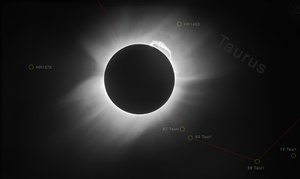
The Eddington experiment was an observational test of general relativity, organised by the British astronomers Frank Watson Dyson and Arthur Stanley Eddington in 1919. The observations were of the total solar eclipse of 29 May 1919 and were carried out by two expeditions, one to the West African island of Príncipe, and the other to the Brazilian town of Sobral. The aim of the expeditions was to measure the gravitational deflection of starlight passing near the Sun.[1] The value of this deflection had been predicted by Albert Einstein in a 1911 paper; however, this initial prediction turned out not to be correct because it was based on an incomplete theory of general relativity. Einstein later improved his prediction after finalizing his theory in 1915 and obtaining the solution to his equations by Karl Schwarzschild. Following the return of the expeditions, the results were presented by Eddington to the Royal Society of London[2] and, after some deliberation, were accepted. Widespread newspaper coverage of the results led to worldwide fame for Einstein and his theories.
- ^ Earman, John; Glymour, Clark (1980). "Relativity and eclipses: the British eclipse expeditions of 1919 and their predecessors" (PDF). Historical Studies in the Physical Sciences. 11 (1): 49–85. doi:10.2307/27757471. JSTOR 27757471.
- ^ Cite error: The named reference
Dyson1920was invoked but never defined (see the help page).